Call Arrival Rate Prediction and Blocking Probability Estimation for Infrastructure based Mobile Cognitive Radio Personal Area Network
Call Arrival Rate Prediction and Blocking Probability Estimation for Infrastructure based Mobile Cognitive Radio Personal Area Network
Volume 2, Issue 3, Page No 1609-1615, 2017
Author’s Name: Neeta Nathani1, a), Gopal Chandra Manna2
View Affiliations
1Research Scholar, Department of Electronics Engineering, G.H. Raisoni College of Enginnering, Nagpur, Maharashtra, 440016, India
2Retd. Chief General Manager, Indian Telecommunication Service, BSNL, Jabalpur, Madhya Pradesh, 482002, India
a)Author to whom correspondence should be addressed. E-mail: neeta_nathani@yahoo.com
Adv. Sci. Technol. Eng. Syst. J. 2(3), 1609-1615 (2017); ![]() DOI: 10.25046/aj0203200
DOI: 10.25046/aj0203200
Keywords: Cognitive-Radio Base Station, Blocking Probability, Grade of Service, Poisson’s model
Export Citations
The Cognitive Radio usage has been estimated as non-emergency service with low volume traffic. Present work proposes an infrastructure based Cognitive Radio network and probability of success of CR traffic in licensed band. The Cognitive Radio nodes will form cluster. The cluster nodes will communicate on Industrial, Scientific and Medical band using IPv6 over Low-Power Wireless Personal Area Network based protocol from sensor to Gateway Cluster Head. For Cognitive Radio-Media Access Control protocol for Gateway to Cognitive Radio-Base Station communication, it will use vacant channels of licensed band. Standalone secondary users of Cognitive Radio Network shall be considered as a Gateway with one user. The Gateway will handle multi-channel multi radio for communication with Base Station. Cognitive Radio Network operators shall define various traffic data accumulation counters at Base Station for storing signal strength, Carrier-to-Interference and Noise Ratio, etc. parameters and record channel occupied/vacant status. The researches has been done so far using hour as interval is too long for parameters like holding time expressed in minutes and hence channel vacant/occupied status time is only probabilistically calculated. In the present work, an infrastructure based architecture has been proposed which polls channel status each minute in contrary to hourly polling of data. The Gateways of the Cognitive Radio Network shall monitor status of each Primary User periodically inside its working range and shall inform to Cognitive Radio- Base Station for preparation of minutewise database. For simulation, the occupancy data for all primary user channels were pulled in one minute interval from a live mobile network. Hourly traffic data and minutewise holding times has been analyzed to optimize the parameters of Seasonal Auto Regressive Integrated Moving Average prediction model. The blocking probability of an incoming Cognitive Radio call has been assessed as a function of instantaneous occupancy and the block size of trunk servers.
Received: 15 June 2017, Accepted: 03 August 2017, Published Online: 24 August 2017
1. Introduction
The mobile communication network is faced with serious challenges to ensure optimum Quality of Service (QoS). In order to survive in this present economic situation, the network operators must put into consideration that the available resources must be effectively used with optimum QoS. This leads to design of effective network and effective network planning. It can be achieved through parameters like call arrival rate, optimum holding time, blocking probability, etc. These parameters are based on available resources and traffic load in the mobile communication network. The proposed work is aimed at developing a traffic model that will predict blocking probability for voice calls in Global System for Mobile Communication (GSM) network.
To have interference free communication, it is imperative that the SUs are able to distinguish between the channels those are currently occupied by PUs and transmit result to Cognitive Radio-Base Station (CR-BS). The CR-BS predicts the availability of vacant channels depending on the past sensing results which directs a channel requesting Secondary User (SU) to associate with vacant channels accordingly. The proposed model shall assess daily traffic pattern based on monthly observation, hourly traffic pattern based on daily observation and minutewise traffic pattern based on hourly traffic observation particularly in and around Primary User (PU) busy minutes when scarcity for PU channels are at peak.
Assume the SUs in the area are covered through ISM band and available with sufficiently high Carrier-to-Interference and Noise Ratio (CINR) so that this part of the network is not a bottleneck. The procedure for initial selection of channel is described as follows:
(a) The Gateway (GW) node scans the area where SU allocation is to be made. It informs to CR-BS about the PU’s activities in the area along with their activities like idle/dedicated and since when it was dedicated.
(b) Listing of all the GWs under the CR-BS is done.
(c) The coverage of the GWs is estimated from different CR-BS’s and is updated in the CR-BS table. The coverage, signal strength, signal quality, etc. are also to be noticed in the table.
(d) Hourwise prediction of weekly occupancy is done at day = dd, hour = hh using static database from dd = 1 to (dd-1) that holds occupancy records of PU on monthly basis. The estimated value of occupancy obtained at hour = hh helps to estimate minutewise occupancy of PU at time t, i.e., at minute = mm.
(e) A dynamic database for minutewise occupancy of PU is obtained and updated. Whenever SU initiates a call request at an instant, the computation of blocking probability is done for each channel.
(f) The list of channels are available for use by the SU at minute = mm+1 which have blocking probability < 0.5.
Blocking probability (BP) at a moment of call demand can be assessed by channel occupancy rate amid last clock hour, e.g., 9am-10am for call request at a moment between 10am-11am, and so on, as in traditional teletraffic hypothesis. This estimation has been additionally enhanced through expectation models taking 9am-10am hour information for a few earlier days. The CR-BS might keep up and occasionally refresh database of channel occupancy during (a) every hour of a day, and (b) minutewise channel occupancy during each hour. Spectrum detecting is a key capacity of intellectual radio to keep the unsafe impedance with PUs and recognize the accessible range for improving utilization of spectrum use. However, the performance in detection techniques is regularly traded off with multipath blurring, shadowing and recipient instability issues. To alleviate the effect of these issues, cooperative spectrum sensing (CSS) has been appeared to be a viable technique to enhance the detection performance by exploiting spatial diversity [1,2].
The CSS is grouped into three classifications as; centralized, distributed, and relay-assisted [3]. In the centralized CSS, the master node collects the sensing information from all the other nodes within the network and the information is shared with all the CR nodes. In distributed CSS, each CR node acts as an independent node for sharing information between various users. Relay assisted nodes are helpful for extending the coverage area of the network.
In all the three detecting techniques listed above, the agreeable CR nodes with fusion centre takes decision about vacant channels. It doesn’t unequivocally specify which SU might get benefit from which CR node in its physical range. Likewise, CR node takes choice of channel accessibility relying upon the then circumstance which may not be sane. Further, CR nodes are not anticipated that would keep up a database for choice support on the selected channels. To comprehend these restrictions in the adhoc CSS, a CR-BS design is proposed. In the CR-BS engineering, a Cognitive Radio- Base Station Controller (CR-BSC) is provisioned which is relied upon to pronounce the channel accessibility in view of the present channel occupancy and the previous history of occupancy of the channels. In this architecture,
(i) SU works as probe for occupied primary and secondary channels accessible in the environment with location data through GPS and transmit to CR–BS for intermittent updation of channel status database.
(ii) To decide if a channel is involved or not, a filtering recurrence is set and for all useful purposes, this examining recurrence is set as one minute. Consequently, when a SU makes a channel demand to CR-BS, CR-BS surveys the accessibility of each channel as a combination of current occupancy in addition to expected vacant time in future from its occupancy history. In this way, occupancy history is atomized in minutes.
(iii) A database is set up in CR-BSC which stacks information in minutes, collected in hours and in days.
A thorough forecast model is utilized to assess the normal vacant time from the time of demand by SU. This count is done at CR-BSC for all accessible vacant channels and the best one is chosen for allocation to the SU.
Several researchers have recommended methods for spectrum sensing, filtering and dynamic spectrum access for use in CR. Probability of channel availability, duration etc. has also been modeled. These models do not identify individual channels available for cognitive radio use effectively. These aspects have been discussed in section 2 viz. Literature Survey. The CR network architecture modeled in the present work is based on observation of 50 cells data for 36 days of PU network. The background study for present work include channel occupancy during a typical day and holding time distribution and has been discussed in Section 3. Section 4 discusses about architecture for infrastructure based CR. Collection of PU data and its call arrival rate prediction has been discussed in Section 5 followed by the blocking probability in Section 6. The relevance of the proposed work is concluded with results in Section 7 followed by the future work in Section 8.
2. Literature Survey
Cognitive Radio SUs accesses unallocated channels to PUs in licensed bands. Secondary users need to dynamically detect and access unused channels of PUs. Spectrum sensing consumes considerable energy, and hence, predictive methods for concluding gross availability of spectrum holes and idle channels can be used to schedule scan frequency and optimize energy consumption of secondary users.
The authors of the paper [4] propose a CR network architecture made out of an arrangement of SUs with or without a secondary Base Station in which CSS is utilized. At the point when environment is highly dynamic, the detected data may not be valuable because of user’s mobility, channel blurring, and so on. The CSS is not an ideal strategy, as individual sensor nodes may encounter heterogeneous false alarm and missed detection because of their diverse locations.
Xiukui Li and Seyed A. (Reza) Zekavat [5] have accepted that different channels which are licensed to PUs, from which SUs can choose any idle channel for correspondence. A method is recommended that empowers SUs to assess direct accessibility in cognitive radio systems when SUs exist together with PUs. The call arrival s of PUs is monitored by the SUs. The simulations are done with the PU data to study the effect of the proposed prediction technique on the communication and have been compared with Seasonal Auto Regressive Integrated Moving Average (SARIMA) model. This model does not specify about the channel updation technique.
The author in [6] discusses about an infrastructure-based CR network architecture integrated in a PU network operating in licensed spectrum band where, the CR network has a centralized network entity such as a base station and associated CR nodes. The proposed architecture overcomes the drawbacks of the Poisson’s modeling.
A two phase joint power and spectrum allocation scheme for a Cooperative Cognitive Radio Network (CCRN) has been discussed in [7]. The PU leases unused licensed spectrum to various SUs utilizing Frequency Division Multiple Access (FDMA) technique. This paper considers the design with respect to PU-SU. This paper lacks spectrum sensing and is, thus, not a pure CR situation.
The authors [8,9] have presented different traffic forecast procedures and have discussed about the process of assessing channel accessibility through predicting traffic patterns of PUs for cognitive radios in an infrastructure of CR network as clarified in [5] above. In this model, SUs can forecast the call arrival rate and call holding time of primary users that utilized this channel. At that point, as per the prediction as well as estimation results, secondary users can assess the probability that the channel would be accessible for a given time period or not. By comparing the assessed probability with some threshold, secondary users can choose whether to utilize this channel. This model doesn’t unequivocally express the need of infrastructure. The sensing, computation and prediction needs high processing ability and more power and are thus hard to implement in practice.
An infrastructure based CR network that empowers cooperative spectrum sharing over different service providers by means of static CR nodes have been proposed in [10,11]. At the point when all the channels of a service provider are accessed or it is over-burden, it can utilize the available channels that are authorized to the service providers that are under loaded. This is not a pure CR subject.
In this manner, it is seen from above literature surveys that no document is sufficiently complete to quantify the availability of vacant channels with adequately free holding time to accommodate a secondary user call. In the present work, the prediction of availability of vacant channels for the proposed holding time of the secondary user is done. These aspects have been incorporated into the present review and results are required to be very helpful to CR building architects.
3. Background Studies
3.1 Daily Traffic Pattern of PU
Conventionally, a telecom operator analyzes the total traffic on hourly basis and identifies the busy hour where total traffic is maximum. Hourly data arranged on weekly basis does not give a clear picture of the peak hour as it contains many peaks. The traffic variations within a clock hour are not predictable in weekly analysis. Thus, data arranged on daily basis is taken to estimate the behavior of hourly traffic. The minutewise collected occupancy data was taken on hourly basis for 50 cells of different channel numbers. Figure 4.3 depicts daily occupancy pattern for the locations with 60 channels (8 RFs) and differently loaded at various traffic places. The results are similar for other Radio Frequency (RF) counts also. The figure indicates double heaps in the channel occupancy. The heap pattern shows near parabolic nature from 05:00 to 15:00 hours and 19:00 to 23:00 hours.
In this analysis, minutewise gathered occupancy information was figured on hourly basis for 50 cells of varying channel numbers, e.g., each cell with 7channels/14 channels/28 channels/60 channels for 1/2/4/8 Radio Frequencies (RFs) of GSM framework. Channels with same number of RFs are some where lightly loaded and highly loaded in some different areas. Areas with 8 RFs (60 channels) and distinctively stacked at various activity areas are shown in figure 1. The outcomes shown are comparable for other RF counts also. The figure shows double heaps in the channel occupancy. The heap design appears near to parabolic in nature from 07:00 to 15:00 hours and 17:00 to 22:00 hours. An observation of instant occupancy together with last two observations might show peak time location along with the occupancy at peak time. This will help to regulate scanning frequency to optimize battery life of the SU. Based on the channel occupancy pattern, SU shall work in three scan states for power consumption optimization given below:
(i) State-I: This is part of the day during which primary traffic is too low, hence any SU request for channels can be serviced by CR-BS system without blockage. The State-I is depicted in figure 1 from 00:00 to 05:00 hours (from points A to B), and from 15:00 to 19:00 hours (from points D to E). During these periods the occupancy is very less and hence, the SU can save its battery power as no scan (scan frequency =0) is required. The SUs may go to sleep mode keeping only its receiver active for receiving paging message from CR-BS system only. In this state, SU RF is active in paging Listen mode from CR-BS but scanner remains inactive. GPS remains inactive while SU is static but restarts when SU is in motion. Manual interrupt is active for switching to dedicated mode for SU.
(ii) State-II: This is part of the day during which primary traffic goes on increasing, hence any SU request for channels can be serviced only when vacant PU channels as are sufficient. As depicted in Figure 1, from 05:00 to 11:00 (from points B to C) and from 19:00 to 20:00 hours (from points E to F), the channel occupancy shows a positive slope at the beginning which requires SUs to periodically scan the environment and update to CR-BS at highest rate to support channel hopping to active SUs.
(iii) State-III: In this state, the scanning frequency becomes active after every few seconds as specified by CR-BSC. The State-III is depicted in figure 1 from 11:00 to 15:00 hours (from points C to D) and 20:00 to 23:00 hours (from points F to G).
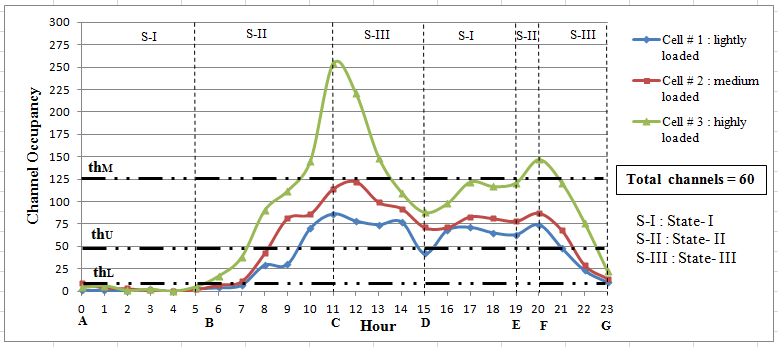 Figure 1. Daily Channel Occupancy Pattern for Three Cells With 60 Channels
Figure 1. Daily Channel Occupancy Pattern for Three Cells With 60 Channels
(iii) State-III: In this state, the scanning frequency becomes active after every few seconds as specified by CR-BSC. The State-III is depicted in figure 1 from 11:00 to 15:00 hours (from points C to D) and 20:00 to 23:00 hours (from points F to G).
3.2.Holding Time Distribution
The data was collected at busy hour for 60 channels and minutewise occupancy was computed. An analysis of 60 minutes calls is practically taken for calculation purpose. The holding time distribution is shown in figure 3. It is observed that 58.5% calls are lying within 1 minute, 75% calls within 2 minutes, 82.9% calls within 3 minutes and 86.4% calls within 4 minutes 90.3% calls within 5 minutes. It is observed that holding time is nearly zero for a large number of calls which are due to transaction of Short Message Service (SMS) and Unstructured Supplementary Service Data (USSD) calls.
Study of figure 2 reveals that holding time of 86.4% calls are 4 minutes and the peak occupancy is 173. So, traffic carried is 173*(8/60) = 23 Erlangs, whereas total traffic maximum traffic carrying capacity is 60 Erlangs, i.e., actual loading is (23/60)*100 = 38.4%. Hence, there is enough vacant space to accommodate SU calls even in busy hour.
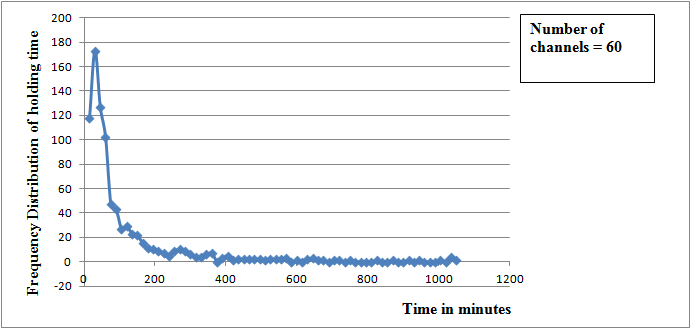 Figure 2. Holding Time Distribution Pattern in Busy Hour
Figure 2. Holding Time Distribution Pattern in Busy Hour
4. CR Architecture and Model
The present document shall use the SU and Cognitive Radio-User Equipment (CR-UE) interchangeably. In previous study [12,13], it has been established that more than 20% of the completely licensed bandwidth is practically vacant in a saturated market environment. This is well above the requirement of 1/8th part of the band to get access to the whole of the bandwidth at a time and adequate to take additional Media Access Control(MAC) level overhead required for C. There is no immediate necessity of these channels by the licensed operators which can be safely deployed as common control channel for cognitive radio purpose. This paper also assumes that the communication shall take place in licensed band channels only so that the UEs can be used as SUs with little modification in access protocol.
The evolved network architecture as shown in figure 3 contains CR nodes which may be combined in exclusive clusters or Personal Area Networks (PANs). The clusters will have a Cluster Head (CH) or GW. The CR-GW shall internally coordinate with sensor nodes using standard 6LowPAN based protocols and CR-MAC protocol for GW to CR-BS communication where it will use the vacant channels of licensed band. The GW will be able to handle multi channel multi radio for communication with BS. It will also have a dedicated RF scanner for monitoring licensed channels and inform channel status change to BS. Unique code will be assigned to all CR-BS. According to capacity of CR-BS in radio side, CR-BS can control number of SUs. In the backbone side, it provides interface to Mobile Switching Center (MSC) through Media Gateway (MGW).
At the time of access for traffic data, GW-SU transmitter ensures that the access of PU channel do not interfere with PU functioning and CINR at BS. Network operators define various traffic accumulation data counters at BS. These parameters are polled at regular intervals for dynamic record of various RF parameters usually on hourly basis (T) and stored in Operations and Maintenance Center for Radio (OMC-R) [fusion centre in present case]. One hour time is too long for critical ON/OFF activity observation. Hence, channel status acquisition information need to be polled and updated at fusion centre at rate >> λ (call arrival rate) of the channels, or, in other words, polling time (τ) <<1/ λ, i.e. channel occupancy repetition time. In addition to periodic polling, both (i) the status of the channel change from free state to occupied state and, (ii) SU channel allocation request should be interrupt driven and get instantly registered in Fusion Centre. Channel allocation shall be made by fusion centre from available list of channels for each channel based on: a) instantaneous channel status i.e. free state; b) amount of time passed since the channel was free; c) channel free time behavior prediction during the hour from data warehouse and d) User call holding time prediction during the hour from data warehouse. Eligible list of channels is thus prepared in order of merit and allocation is made by the switching centre depending upon the user service type request and QoS eligibility of the user.
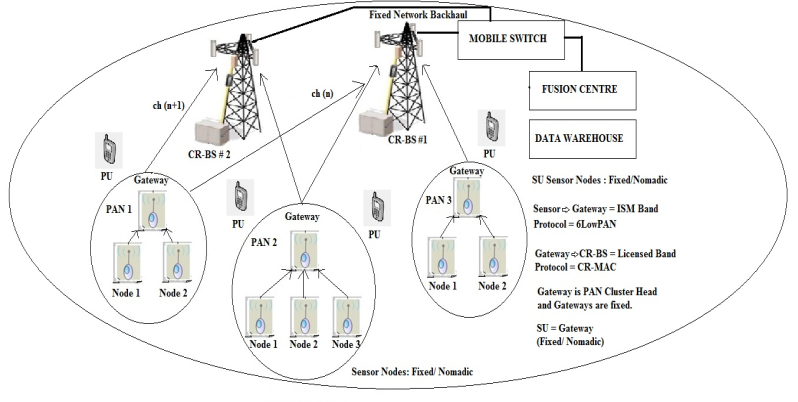 Figure 3. Cognitive Radio Cellular and Sensor Network
Figure 3. Cognitive Radio Cellular and Sensor Network
The proposed architecture also assumes that the communication shall take place in licensed band channels only so that the UE can be used as SUs with little modification in access protocol. PUs will communicate through BSC whereby SUs are located in between different PUs. The SU shall communicate through CR-BSC. The CR-BSC contains transceiver assembly based on Software Defined Radio (SDR) architecture, an exclusive wideband RF receiver and a Global Positioning System (GPS). Also it is expected that every SUs need to have in built GPS facility. The job of SU transceiver is to monitor channel occupancy information and the signal levels for all PUs. The CR-BS receiver collects the information such as channel occupancy from SUs. Thus the CR-UE shall take the role of static CR node for cooperative sensing with exception that it is mobile. On the other hand, the idea of swapping the dynamic database among CR nodes is missing. Instead, the database acquired by an SU during a specific duration is sent to a central node i.e., CR-BSC through CR-BS.
Secondary infrastructure might stay associated with CR-BSC for cognitive call handling function. CR-BSC shall hold the tables and decision logic for allocation of channels to SUs. In like manner, the spare channels and the assigned frequencies are distributed by CR framework in order to have minimum interference.
5. Call Arrival Rate Prediction
CR infrastructure and CR users are same as licensed user framework with the exception of that CR frameworks needs to follow the mandatory guideline that: (a) exclusive vacant channels of PU are to be utilized and returned when PU is active on this channel, (b) it won’t cause any noise to PU framework. In this way, SU design might contain some extra logic than PU framework; else they are basically the same. Accordingly, it is basic to examine altogether the PU behavior for drawing conclusions about CR traffic handling effectively.
A review was completed for 42 days for 7 channels of various geographic and business significance of the city e.g., local location, market, play area and so forth, out of which 35 days (7 weeks) information was utilized for development of the model and one week (7 days) information was forecasted and verified with actual days information from 36th day to 42nd day to guarantee goodness of fit.
In this analysis, 35 days information of every cell was gathered and arranged on hourly basis and one specific hour was chosen. It was expected that hourly information might follow a weekly pattern and then a period of 7 days was taken after. SARIMA model was applied to forecast 7 days information for that specific hour in view of 35 days observed information of that hour. The prediction of traffic pattern for a week follows the following relationship:
Forecast Occupancy = Fi = Si * Tj
where, i = 1 to 7 as one week is considered as a seasonal unit,
j = 1 to n,
n= number of days of observation = 35 in present analysis.
Ti ={A0-A1*Dj},
Si = Seasonal Coefficients;
A0& A1= Intercept Coefficients obtained from SARIMA modeling.
A lag of 7 was observed to be ideal fit for predicted data with actually obtained result. In this way SARIMA model of (7,7,7) was found to be best fit after application on 7 channels. Such perception for an estimated busy hour has been plotted in Figure 4.
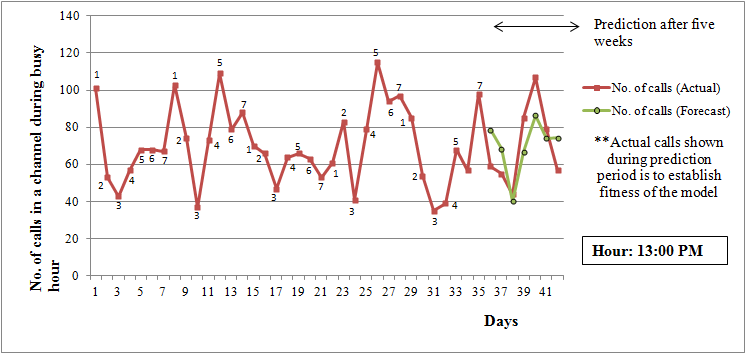 Figure 4.Forecast of Channel Availability during Busy Hour: 13:00 PM of Each Day of Five Weeks Observation Using SARIMA Approach
Figure 4.Forecast of Channel Availability during Busy Hour: 13:00 PM of Each Day of Five Weeks Observation Using SARIMA Approach
Investigation of the plots for week after week observation demonstrates reliable conduct from week to week as shown by digits 1 to 7 in the figure 4. This information is stored and updated in data warehouse of the CR-BSC for long term forecast.
The prediction of availability of vacant primary channels or in other words, occupancy of primary channels during the holding time of SU is essential, in particular, in and around peak occupancy. Despite the fact that, the parabolic model gives an idea of peak occupancy time and peak occupancy count from static perception however it can’t be completely depended upon [14]. Thus, prediction mechanism is essential about busy hour and at least for the duration of the holding time.
The probability that no call arrives (Pi(0)) during the holding time of SU (τ) was calculated using the relation:
Pi(0) = exp –[(λ/60)* τ]
where, λ = call arrival rate of PU,
τ = holding time of SU
It is found in figure 5, even if we assume that call arrival rate of PU = 8 with τ = 3 minutes, the SU call will mature with probability of 0.67.
6. Blocking Probability
The determination of QoS provided by a particular network configuration is required for an efficient design of communication networks [15]. Whenever a customer makes a telephone call, the routing equipment will decide to reroute the call to alternative equipment, to receive the call or to reject it entirely. Call rejection is occurred because of heavy traffic loads (congestion) on the system which results in either call being delayed or lost. The blocking probability is defined as the probability that the call attempts cannot be handled successfully due to unavailability of the radio resources (i.e. unavailability of free circuits or other switching equipments).
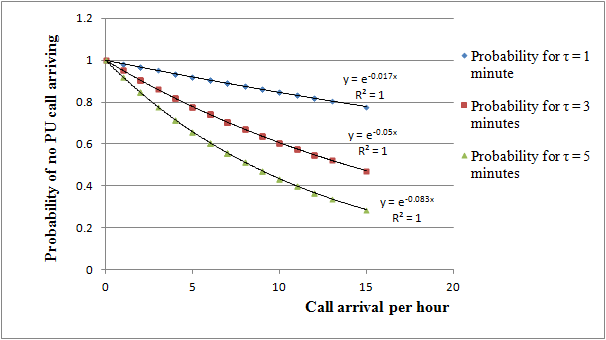 Figure 5. Graph of Probability of No Call Arriving Of PU, Pi(0) vs Number of Vacant Channels with Different Holding Time Of SU (τ)
Figure 5. Graph of Probability of No Call Arriving Of PU, Pi(0) vs Number of Vacant Channels with Different Holding Time Of SU (τ)
Efficient design of communication networks requires the ability to determine the quality of service provided by a particular network configuration. A common quality of service measure is the blocking probability, which is the probability that a new call will not be admitted to the network due to insufficient network resources [16].
Using the Poisson theorem, the probability that a call will be blocked can be calculated as:
where, P(c,a) = the proportion of offered load that is blocked using the Poisson model given “c” servers and “a” offered load.
For a Lost Call system, the Grade of Service (GoS) for CR shall be measured by using modified Poisson’s Model, as proposed in this work is given by the equation:
where, k = 0 to (c-1) with c = total number of trunked channels, N=Np+Ns, Np = Count of PUs in the system, Ns = σNp + offset = Count of SUs in the system, where, 0 < σ ≤1. A portion of the PU, σ (known as SU factor) can be considered for the calculation of the blocking probability of a secondary call combined with PUs traffic in the system. Also, 0<offset<1 such that Ns is an integer of higher value. These values of GoS help to determine whether the channel allocation to SU shall be successful or fail.
At the point when a cellular system is planned, the blocking probability P should be less than some pre-determined value. An observation for varying channels was made with c= 60 servers and is depicted in figure 6.
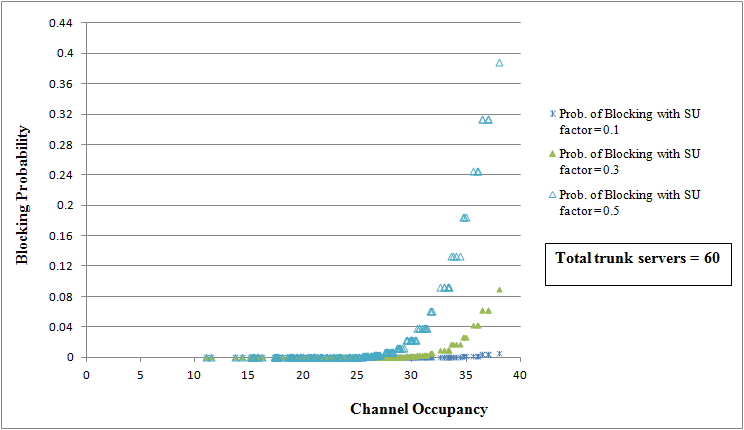 Figure 6.Call Blocking Probability with Trunk Servers (c) = 60 using Poisson’s Model
Figure 6.Call Blocking Probability with Trunk Servers (c) = 60 using Poisson’s Model
It is observed from figure 6 that BP is ≤ 0.02 when channel occupancy is half to that of total available channels. When occupancy further increases, blocking probability increases exponentially depending upon secondary user occupancy factor.
7. Discussions on Results and Conclusion
The study establishes that there are scanty occupancy of PU channels about 16 hours of a day during which large quantum of SU can be allocated without problem. The performance of SU can be further improved in case, the traffic holding time is less than 1 minute. The SARIMA prediction model with a periodicity of 7 ideally fits the predicted data. It is also established that when the PU channel occupancy is 50%, the CR-BS shall provide voice channel to SU with blocking probability ≤ 0.02, where industry standard for blocking is 0.02.
8. Future Work
The SARIMA method is a better method for prediction of channel occupancy rate which takes into account the auto regression and moving average method along with the seasonal parameters. But still there is a scope of further improvement in the results of prediction by including three exponential smoothening factors viz. (a) the level (or mean) that can be smoothed to give a local average value for the series of data, (b) the trend that can be smoothed, and (c) each seasonal sub-series (i.e., all the values of Monday, all the values of Tuesday, etc. for weekly data) that can be smoothed separately to give a seasonal estimate for each of the seasons. Some other methods like Holt-Winters (HW) additive technique may provide more predictive results.
Conflict of Interest
The authors whose names are listed immediately below certify that they have NO affiliations with or involvement in any organization or entity with any financial interest (such as honoraria; educational grants; participation in speakers’ bureaus; membership, employment, consultancies, stock ownership, or other equity interest; and expert testimony or patent-licensing arrangements), or non-financial interest (such as personal or professional relationships, affiliations, knowledge or beliefs) in the subject matter or materials discussed in this manuscript.
- Niranjan Muchandi, Rajashri Khannai, “Cognitive Radio Spectrum Sensing: A Survey”, IEEE International Conference on Electrical, Electronics and Optimization Techniques (ICEEOT), 3- 5 March 2016, ISBN: 978-1-4673-9939-5/16, Pg 3233-3237.
- Tabakovic, Zeljko, “A Survey of Cognitive Radio Systems”, Post and Electronic Communications Agency, Jurisiceva 13, 2013.
- Navpreet Kaur, Inderdeep Kaur Aulakh, “A Survey of Cooperative Spectrum Sensing in Cognitive Radio Networks”, International Journal on Recent and Innovation Trends in Computing and Communication, Vol. 3, issue 11, ISSN: 2321-8169, Pg. 6313-6316.
- Beibei Wang and K. J. Ray Liu, “Advances in Cognitive Radio Networks: A Survey”, IEEE Journal of selected topics in Signal Processing, Vol. 5, No. 1, February 2011, Pg. 5-23.
- Xiukui Li and Seyed A. (Reza) Zekavat “Cognitive Radio Based Spectrum Sharing: Evaluating Channel Availability via Traffic Pattern Prediction”, Journal of Communications and Networks, Vol. 11, No. 2, April 2009, Pg. 104-114.
- Berk Canberk, Ian F. Akyildiz, and Sema Oktug:, “ Primary User Activity Modeling Using First-Difference Filter Clustering and Correlation in Cognitive Radio Networks”, IEEE/ACM Transactions on Networking, Vol. 19, No. 1, February 2011, Pg. 170-183.
- Rahul Bajpai, Aditya Trivedi, “ Joint Power and Spectrum Allocation for Cooperative Cognitive Radio Network with End User Mobility”, International conference on Wireless and Optical Communications Networks (WOCN), 2014 Eleventh International Conference, 11-13 Sept. 2014, IEEE, Pg. 1-5.
- Xiukui Li and Seyed A. (Reza) Zekavat, “Traffic Pattern Prediction Based Spectrum Sharing for Cognitive Radios”, Lecture notes in Electrical and Electronic Engineering, Published: November 1, 2009 under CC BY-NC-SA 3.0 license ISBN 978-953-307-021-6.
- X. Li S.A. (Reza) Zekavat, “Spectrum sharing across multiple service providers via cognitive radio nodes”, IET Communication, Vol. 4, Iss. 5, 2010, Pg. 551–561,
- R. Kaniezhil and Dr. C. Chandrasekar, “ Multiple Service providers sharing Spectrum using Cognitive Radio”, International Journal of Scientific & Engineering Research, Volume 3, Issue 3, March-2012, Pg. 1-7.
- R. Kaniezhil, Dr. C. Chandrasekar, S. Nithya Rekha, “Channel Selection for Selective Sensing using Cognitive Radio Nodes”, International Journal of Computer Applications, Vol.39, No.3, February 2012, Pg. 20-25.
- Neeta Nathani, G C Manna, S B Mule, “ An Empirical Assessment of Quasi-Permanently Vacant Channels in Mobile Communication Bands for Cognitive Radio”, ICACT Transactions on Advanced Communications Technology (TACT) Vol. 3, Issue 1, January 2014, Pg. 389-394.
- Neeta Nathani, G C Manna, S B Mule, “Assessment of Quasi-Permanently Vacant Channels in Mobile Communication Bands for Cognitive Radio”, ICACT 2013, January 2013, ISBN 978-89-968650-0-1, Pg. 484-488.
- Neeta Nathani, G C Manna, S B Mule, “Dynamically Available Channel Model for Cognitive Radio in GSM Band”, Proceedings of National Conference on Trends in Signal Processing & Communication (TSPC’14), 12th –14th April 2014, ISBN: 978-93-83842-40-7, Pg. 8-12.
- Neeta Nathani. G.C.Manna, “Quality of Service challenges for mobile Cognitive Radio”, 2015 International Conference on Computer Science and Environmental Engineering, May 17-18, Beijing, China, ISBN: 978-1-60595-240-6, Pg. 967-998.
- Neeta Nathani, G.C.Manna, S.S.Dorle, “Network Architecture Model of Infrastructure based Mobile Cognitive Radio System in Licensed Band with Blocking Probability Assessment”, IEEE Future Technologies Conference (FTC 2016), 6-7 December 2016, ISBN: 978-1-5090-4171-8/16, Pg. 231-236.

